I’am so proud to share Desertinho Atlantic whale observation it’s results for the Whale Photo-ID and Whale Observation projects I worked on in 2022 and 2023! Both years, I travelled more than 1200 nautical miles on the Atlantic Ocean, and did I observed in more then 115 hours 12 different whale species. A great result together with amazing memories how beautiful whale conservation can be.
Blue Whale Photo ID Result:
In 2023 I had a special observation of a blue whale in the broadest sense of the word! I really never imagined this would happen to me. It was a relatively quiet morning with nice stable weather and the lookout told us that a Sei whale had been located. Based on the GPS data we received, we sailed to that location and indeed she was there. It was noticed that this sei whale swam fast and showed special behavior such as swimming sideways. I was able to take a few pictures and just as our time limit was up and most of us had put away their cameras, the most unlikely thing happened!
A blue whale that jumped out of the water out of the blue! We call that “breaching” and there is not really a Dutch word for it. In addition, it is also true that this behavior is very rare for a blue whale and luckily, I had my camera ready and was able to capture this behavior on image. As quick as the blue whale came, he was gone and we never saw her again. Fortunately I was also able to take pictures of her left side and have these pictures assessed by experts.
This assessment is a critical and lengthy process and has therefore taken almost a year and the result can be called special! This identification process takes so long because this identification, in addition to Desertinho Atlantic whale observations, must be carried out by 3 other qualified experts. This blue whale had never been seen before and is now included in the Atlantic blue whale catalogue. A result of which I’am obviously very proud of.
Long-fin Pilot whale vs. grey/ Risso’s dolphin:
In 2023 I was able to make clear observations of long-finned pilot whales for the first time. Very special to observe this whale species near the Azores. The long-finned pilot whale normally lives in the North Atlantic, but now this pod had moved very far south. The pod of long-finned pilot whales stayed all week in the area where I was and that was certainly special to observe. Besides the beautiful pictures I took was it very special to be a witness of the interaction of the pod long-finned pilot whales together with the gray dolphins or Risso’s dolphin.
In the first few days it seemed to go pretty well, but on one day the Risso’s dolphins tried to chase the pod of long-finned pilot whales out of their resident area. The underwater images were impressive! The Risso’s tried to attack the long-finned pilot whales from below and the long-finned pilot whales immediately swam into a defensive formation. Such a defensive formation means that the calves, vulnerable, and females are placed in the middle of the pod and the males on the outside. The long-finned pilot whales were not impressed by the Risso’s their behavior, but eventually left their area.
I found the special thing about this observation that Risso’s never have issues with the short-finned pilot whale, but they do with the long-finned pilot whale. It will probably lie in the fact that both species hunt for the same food at the same depth.
Stranded long-finned pilot whales in Scotland explained:
In 2022 and 2023 there have been many media reports about pilot whale strandings. It is special on one hand that this happens and especially often with this whale species. However, this has to do with the special and strong bond of this whale species. This concerns both the short-finned pilot whale and the long-finned pilot whale. Usually, these strandings are in the southern hemisphere, but this time it was in Europe, namely on Lewis beach Scotland on the 16th of July.
I’ve read several reports from experts and the most common cause of this stranding was a pregnant female in the pod. However, what was missing in the investigation is that an overall investigation was not carried out, such as, for example, what happened in the vicinity of this stranding. I came to the following conclusion.
This pod of long-finned pilot whales had survived the Grind in the Faroe Islands. The Faroe Islands are about 413 kilometers away from Lewis beach Scotland. The stranding of this pod of long-finned pilot whales in Scotland occurred just a couple of days after the “Grind” in the Faroe Islands on the 9th of July.
The Grind is a traditional whaling hunt in the Faroe Islands where pilot whales are killed in a horrible way. This pod of stranded long-finned pilot whales escaped this hunt and swam away in panic and stranded in Scotland a couple of days later. The sound in water carries for miles and this pod of long-finned pilot whales had heard all the communication of the eventually killed pilot whales and swam away in panic, resulting in this mass stranding. A pilot whale can easily cover a distance of 413 kilometers from the Faroe Islands to Scotland and certainly the condition this pod was in.
Conclusion of this piece is that whale experts should not always focus on tunnel vision but also all events surrounding the areas of a whale stranding. Research and section on these pilot whales will not tell us a thing.
Deep-sea whale sightings:
During the pandemic, it was also not possible for me to do whale observations and participate in whale photo ID projects but luckily the local experts were able to do this during this period. This, of course, under strict conditions. From a distance, the cooperation has therefore remained and we were able to continue with whale observations and whale photo ID. projects. The frequency of sailing was significantly less and because tourism was not possible, not many other observations were made in that period. The most special thing about that period was the number of sightings of all kinds of deep-sea whales, such as Blainville’s beaked whales.
54% of whales sighted in the Atlantic Ocean:
In my 15 years of doing whale observations myself, I have been able to observe 54% of all Atlantic whale species. A beautiful score, of course, but there are still a large number of whales that I have not been able to observe. The species I have almost no sightings of are specifically the deep-sea whale species. The reason why is that I always travel in spring and early summer specifically for the baleen and sperm whales.
All 15 whale species on my website are whale species that I have observed very well. The criteria per species is that I have been able to make observations for at least 10 hours before I place them on the website. Other criteria I use here is that I have had to observe them for several years, in different locations, different weather conditions, etc.
Humpback whale sighting 2023:
Since doing whale observations I have been able to observe and identify several humpback whales which is really impressive. This whale species is very special and of course I know many documentaries about humpback whales with beautiful images. Really that had never happened to me myself because most humpback whales were usually migrating when I encountered them. Until 2023, A day I will never forget.
On the morning that we left the visibility was poor but we decided to sail anyway. We had seen little all morning but suddenly our lookout from land communicated that he had seen a baleen whale at certain GPS coordinates. The weather had apparently cleared from land. At that time, we were all alone when we arrived at the place in question. Unfortunately, there was nothing to see but we decided to stay and wait for things to come. We had turned off the engine and floated on the Ocean and the weather cleared up with us.
Suddenly, out of nowhere, a huge humpback came out from under our boat! The humpback whale was so impressive in size and stayed with us for 25 minutes. She regularly came swimming towards us and diving under the boat and gesturing with it’s impressive pectoral fins. These are so white and colored so beautifully with the green-blue ocean water. We just floated with the boat and the humpback whale sought interaction with us. After 25 minutes we had to leave, those are the rules, and this has been an observation to never forget.
Desertinho, what does this name mean:
This is a question that I have been asked many times over the last 10 years! Verbally I have often told what this name is based on and since I started my website I often see the search term in Google: What is Desertinho. Everything you find about it is unfortunately not an answer to the meaning of this name.
It is a derived and unique name. Once you start a website it is difficult to come up with a short and international one that is also unique and corresponds to one of the greatest languages in the world namely Portuguese. My working area is in the autonomous regions of Portugal: Madeira and the Azores. The Crossroads of the Atlantic Ocean for 28 whale species, but also an area where the rare monk seal (Monachus monachus) can be found.
The name Desertinho is the masculine name of Desertinha. The name Desertinha is my inspiration for the name Desertinho. Desertinha, a monk seal or Lobo Marinho, was the founder of the vulnerable population of monk seals at Ilha Desertas. This group of islands lie off the coast of Madeira. She ensured that the monk seal population recovered reasonably well in the Atlantic Ocean. She is still an inspiration to me and I want to honor her.
Desertinha was one of the first identified monk seals on the Desertas Islands and one of the first individuals to be sighted on Madeira itself. She made a great contribution to increasing the monk seal population, giving birth to 9 pups during her lifetime.
We both stand for the same thing, Desertinha and Desertinho is a derivative of the name Desertas islands: Rugged, rough, inhospitable, deserted, abandoned.
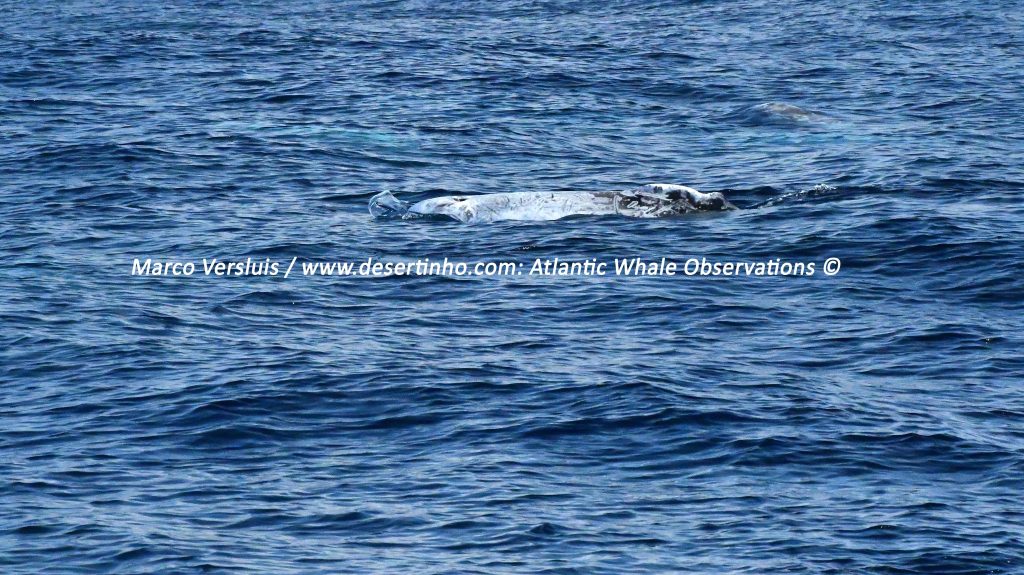
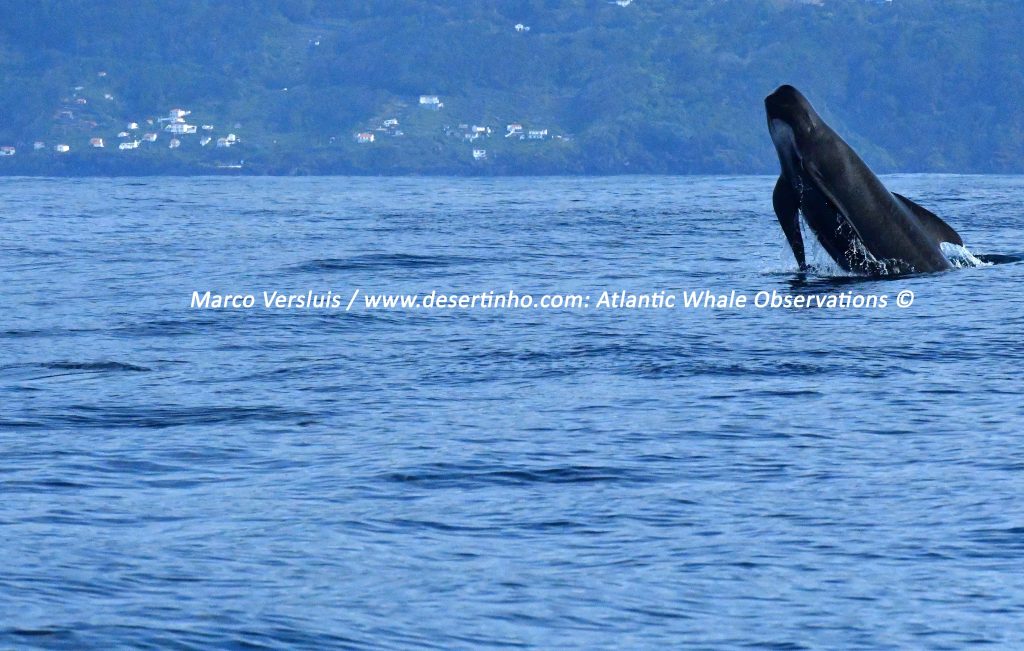
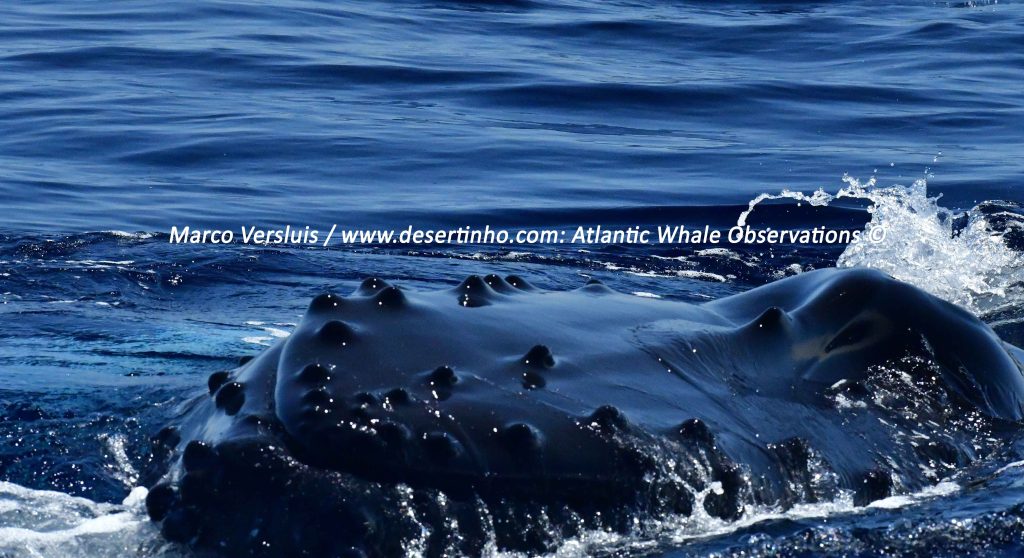
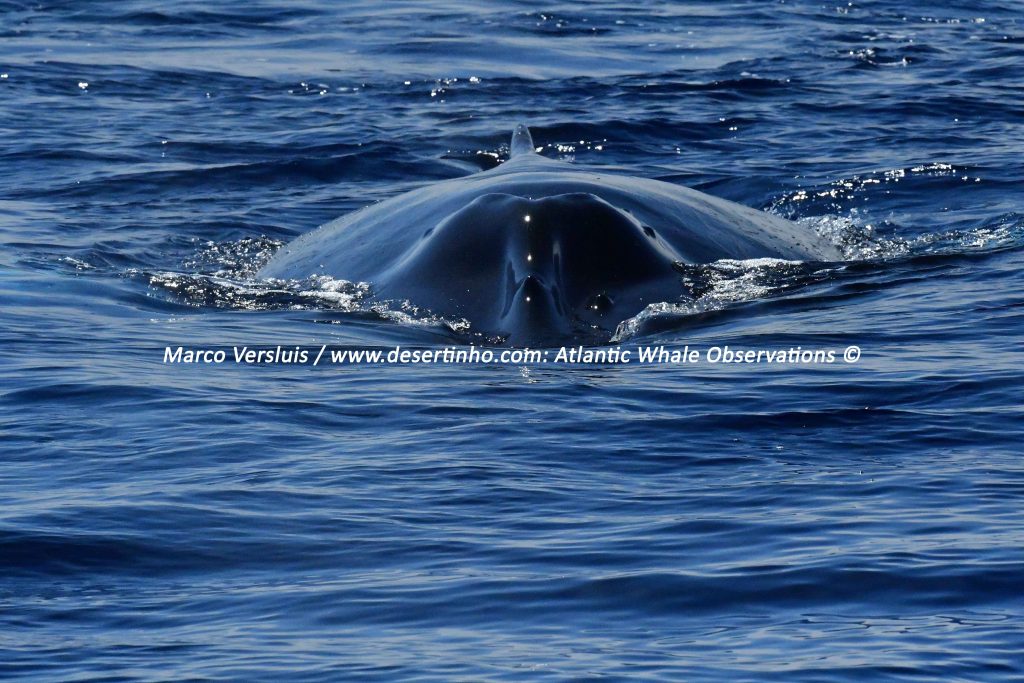
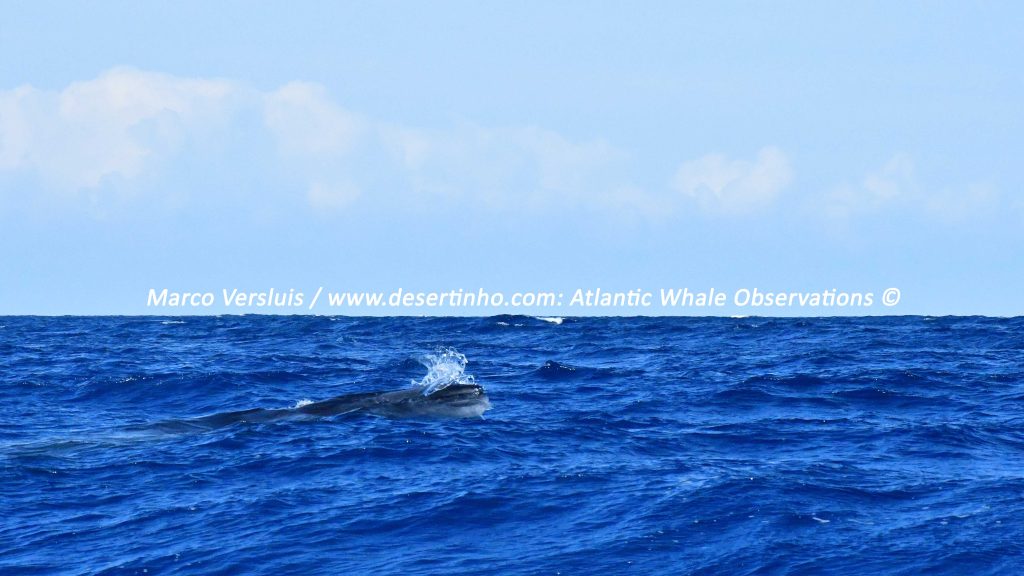
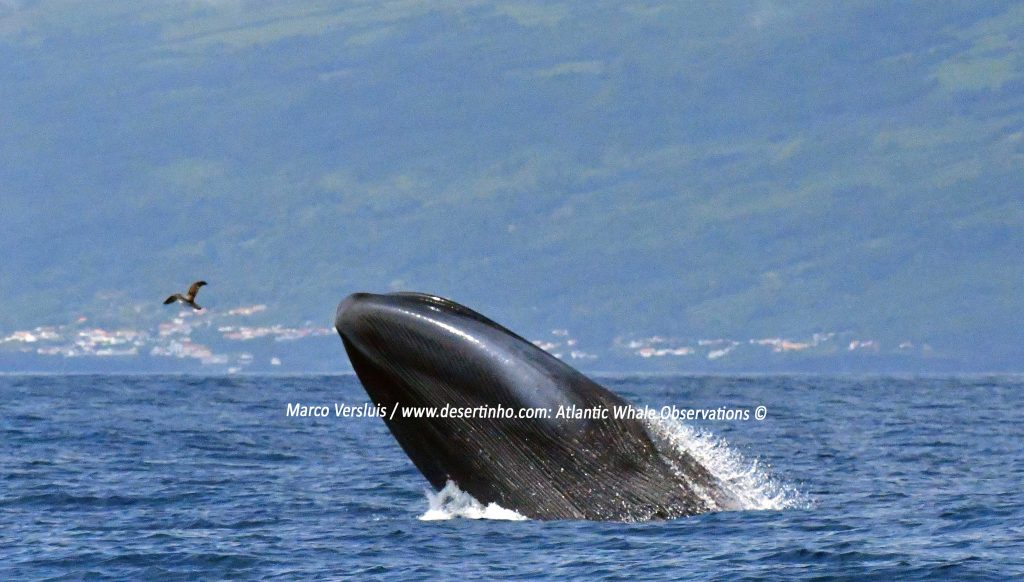
Desertinho Atlantic Ocean: Whale Photo-ID 2023 and Whale observation results of 2023:
Met trots wil ik hierbij de resultaten van Desertinho Atlantic Whale observations “Bloggen” voor wat betreft de Walvis Foto-ID en Walvis Observatie project resultaten van 2022 en 2023. In beide jaren heb ik meer dan 1200 Nautische mijlen gevaren op de Atlantische Oceaan en heb ik in 115 uur 12 verschillende walvis soorten goed kunnen observeren. Een prachtig resultaat met bijzondere en blijvende herinneringen! Ik vind het zo bijzonder en mooi om walvissen te observeren in hun natuurlijke omgeving waar ze zichzelf zijn!
Blauwe vinvis foto-ID resultaat:
In 2023 had ik een bijzondere waarneming van een blauwe vinvis in de breedste zin van het woord! Ik had dit werkelijk nooit kunnen bedenken dat dit me zou over komen. Het was namelijk een relatief rustige ochtend met mooi stabiel weer en de lookout vertelde ons dat er een Noordse vinvis was gelokaliseerd. Aan de hand van de GPS-gegevens die we doorgekregen zijn we naar die locatie toe gevaren en inderdaad daar was hij. Het viel op dat deze Noordse vinvis snel zwom en bijzonder gedrag vertoonde zoals zijdelings zwemmen. Ik heb er een aantal foto’s kunnen maken en juist op het moment dat onze tijdslimiet voorbij was en de meeste van ons hun camera’s hadden op geborgen gebeurde het meest onwaarschijnlijke!
Een blauwe vinvis die uit het niets uit het water sprong! “Breachen” noemen we dat en daar is niet echt een Nederlands woord voor. Daarnaast is het ook nog eens zo dat dit gedrag voor een blauwe vinvis zeer zeldzaam is en gelukkig had ik mijn camera paraat en heb dit gedrag op beeld vast kunnen leggen. Zo snel als de blauwe vinvis kwam was hij ook weer weg en hebben we hem niet meer gezien. Gelukkig had ik ook foto’s kunnen maken van zijn linker zijkant en heb ik deze foto’s door deskundigen laten beoordelen.
Dit beoordelen is een kritisch en langdurig proces en is er dan ook bijna een jaar overheen gegaan en het resultaat was bijzonder te noemen! Dit identificatie procesduur zo lang omdat dit identificeren, naast Desertinho Atlantic whale observations, door nog 3 andere gekwalificeerde deskundigen moet worden uitgevoerd. Deze blauwe vinvis was nooit eerder waargenomen en is nu dan ook opgenomen in de Atlantische blauwe vinvis catalogus. Een resultaat waar ik uiteraard zeer trots op ben.
Lang-vin Griend vs. grijze/ Risso’s dolfijn:
In 2023 heb ik voor het eerst duidelijke observaties kunnen doen van lang-vin grienden. Uiterst bijzonder om deze walvissoort waar te nemen in de Azoren. De lang-vin griend leeft normaal gesproken in de Noord-Atlantische Oceaan maar nu was deze pod heel ver zuidelijk afgezakt. De pod lang-vin grienden zijn de hele week gebleven in het gebied waar ik was en dat was zeker bijzonder om waar te nemen. Naast de prachtige foto’s die ik heb kunnen maken was het meest indrukwekkende de interactie met grijze dolfijnen / Risso’s dolfijnen.
In de eerste paar dagen leek het in principe best goed te gaan tussen beide walvissoorten maar op een dag probeerden de Risso’s dolfijnen de pod lang-vin grienden uit hun gebied te verjagen. De onderwater beelden waren indrukwekkend! De Risso’s probeerden de lang-vin grienden van onderaf aan te vallen en de lang-vin grienden gingen direct in een defensieve formatie zwemmen. Zo een defensieve formatie beteken dat de kalveren, kwetsbaren, en vrouwtjes in het midden van de groep plaatsnemen en de mannetjes aan de buitenkant. De lang-vin grienden waren verder niet echt onder de indruk de Risso’s maar zijn uiteindelijk wel weer vertrokken uit het gebied.
Het bijzondere van deze waarneming vond ik dat Risso’s bijna nooit issues hebben met de kort-vin griend maar wel met de lang-vin Griend. Het zal waarschijnlijk in het feit liggen dat beide soorten op dezelfde diepte naar voedsel jagen.
Gestrande lang-vin grienden in Schotland verklaart:
In 2022 en 2023 zijn er veel berichten in de media verschenen over strandingen van grienden. Het is bijzonder aan de ene kant dat dit gebeurt en vooral met deze walvissoort. Echter dit heeft te maken met de bijzondere en sterke band van deze walvissoort onderling. Dit betreft zowel de kort-vin griend als de lang-vin griend. Meestal zijn deze strandingen op zuidelijk halfrond maar dit keer was het in het Europa namelijk op de kust van Lewis beach Schotland op 16 Juli.
Ik heb diverse berichtgevingen voorbij zien komen van deskundigen en wat het meest werd genoemd was de oorzaak van deze stranding een zwanger vrouwtje in de pod. Echter wat miste in het onderzoek is dat er niet een overall onderzoek is gedaan zoals bijvoorbeeld wat er zich in die omgeving van deze stranding heeft afgespeeld. Ik kwam hierbij tot de volgende conclusie.
De pod lang-vin grienden is gestand in het uiterste noorden van Schotland op Lewis beach. Dit gebied ligt hemelsbreed zo’n 413 kilometer van de Faeröer eilanden. De stranding van deze pod lang-vin grienden in Schotland vond plaats binnen een aantal dagen na de “Grind” op de Faeröer eilanden op 9 Juli.
De Grind is een traditionele walvisjacht op de Faeröer eilanden waar grienden op een vreselijke manier worden gedood. Deze groep gestrande lang-vin grienden is ontsnapt aan deze jacht en in paniek weggezwommen en vervolgens gestrand in Schotland. Het geluid in water draagt kilometers ver en deze pod lang-vin grienden heeft alle communicatie van de uiteindelijk gedode walvis soortgenoten gehoord en is in paniek weggezwommen met deze stranding tot gevolg. Een Griend kan een afstand van 413 kilometer van de Faeröer eilanden naar de Schotland namelijk makkelijk afleggen in 3 dagen en zeker in de toestand waar deze pod zich in bevond.
Conclusie van dit stuk dat walvis deskundigen zich niet altijd tot een tunnel visie moeten concentreren maar ook alle gebeurtenissen rondom de gebieden van een walvisstranding. Onderzoek zal dan ook niks opleveren van de sectie op deze walvissen.
Waarnemingen diepzee walvissoorten:
Tijdens de pandemie was het ook voor mij niet mogelijk om walvis observaties te doen en mee te werken aan walvis foto-id. projecten maar gelukkig konden de lokale deskundigen dit wel doen tijdens deze periode. Dit onder strikte voorwaarden uiteraard. Vanaf afstand is de samenwerking dan ook gebleven en konden we redelijk door gaan met walvis observaties en walvis foto-id. projecten. De frequentie van varen was beduidend minder en doordat er geen toerisme mogelijk was werden er heel veel andere waarnemingen gedaan in die periode. Het meest bijzondere van die periode waren de hoeveelheid waarnemingen van alle soorten diepzee walvissen zoals bijvoorbeeld de Blainville’s walvissen.
54 % van de walvissen waargenomen in de Atlantische Oceaan:
In de 15 jaar dat ik zelf walvis observaties doe heb ik de balans opgemaakt en heb ik 54% van alle Atlantische walvissoorten kunnen waarnemen. Een prachtige score uiteraard maar zijn er nog een groot aantal die ik niet heb kunnen waarnemen. De soorten waar ik bijna geen waarnemingen van heb zijn specifiek de diepzee walvissoorten. De reden waarom is dat ik altijd in de lente en begin zomer specifiek voor de balein walvissen en potvissen afreis.
Alle 15 walvissoorten op de website zijn walvis soorten die ik goed heb kunnen observeren en kunnen waarnemen. Per soort is de criteria dat ik minimaal 10 uur waarnemingen heb kunnen doen voordat ik ze op de website plaats. Andere criteria die ik hierbij hanteer is dat ik ze meerdere jaren heb moeten kunnen waarnemen, op verschillende locaties, verschillende weersomstandigheden, enz.
Bultrug waarneming 2023:
Sinds ik walvis observaties doe heb ik meerdere bultruggen kunnen waarnemen en identificeren wat echt indrukwekkend is. Deze walvissoort is heel bijzonder en ik ken natuurlijk veel documentaires over bultruggen met prachtige beelden. Echt was mij dat zelf nog nooit overkomen want de meeste bultruggen waren meestal aan het migreren als ik ze tegenkwam. Tot in 2023, Een dag die ik nooit zal vergeten.
Op de bewuste ochtend dat we vertrokken was er slecht zicht maar besloten we toch te gaan varen. We hadden de hele ochtend weinig gezien maar opeens communiceerde onze lookout vanaf land dat hij een balein walvis had gezien op bepaalde GPS-coördinaten. Het was blijkbaar opgeklaard vanaf land. Op dat moment waren we helemaal alleen toen we aankwamen op de bewuste plek. Helaas was er niks te zien maar besloten we te blijven om te wachten op de dingen die zouden kunnen komen. We hadden de motor uitgezet en dobberden op de Ocean en klaarde het weer ook op bij ons.
Ineens vanuit het niets kwam er een enorme bultrug onder onze boot vandaan! De bultrug was zo indrukwekkend groot en is 25 minuten bij ons gebleven. Ze kwam met regelmaat naar ons toe zwemmen en onder de boot door duiken en gebaren maken met zijn indrukwekkende voorvinnen. Deze zijn zo wit en kleurden zo prachtig met het groenblauwe oceaanwater. Wij dreven gewoon met de boot en de bultrug zocht dus zelf de interactie met ons op. Na 25 minuten moesten we vertrekken, dat zijn nu eenmaal de regels, en is dit een waarneming geweest om nooit te vergeten.
Desertinho, wat betekend deze naam:
Dit is een vraag die mij de afgelopen 10 jaar heel vaak is gesteld! Mondeling heb ik dan ook vaak verteld waar deze naam op is gebaseerd en zie ik sinds ik mijn website begon in Google vaak de zoekterm: Wat betekend Desertinho. Alles wat je er over vindt is helaas niet antwoord op de betekenis van deze naam.
Het is namelijk een afgeleide en een unieke naam. Zodra je een website begint is moeilijk om een korte en internationale te verzinnen die ook nog eens uniek is en overeenkomt met een van de grootse talen ter wereld namelijk het Portugees. Mijn werkgebied is namelijk in de autonome regio’s van Portugal: Madeira en de Azoren. De Crossroads van de Atlantische Oceaan voor 28 walvissoorten maar ook een gebied waar de zeldzame monniksrob (Monachus monachus) nog voorkomt.
De naam Desertinho is de manlijke naam van Desertinha. De naam Desertinha is mijn inspiratie voor de naam Desertinho. Desertinha, een monniksrob of Lobo Marinho, was namelijk de grondlegger van de kwetsbare populatie monniksrobben bij Ilha Desertas. Deze groep eilanden liggen voor de kust van Madeira. Zij heeft ervoor gezorgd dat de populatie monniksrobben zich toen redelijk herstelde in de Atlantische Oceaan. Zij is nog steeds een inspiratiebron voor mij wil ik haar hierbij ook eren.
Desertinha was de eerste geïdentificeerde monniksrob bij Ilhas Desertas en is een van de eerste monniksrobben die werd waargenomen bij Madeira. Zij alleen heeft een grote bijdrage geleverd aan het de stijging van het aantal monniksrobben doordat ze 9 pups heeft gekregen gedurende haar leven.
Desertinha en Desertinho is een afgeleide van de naam Desertas: Ruig, afgelegen, onherbergzaam, verlaten, en op zichzelf.